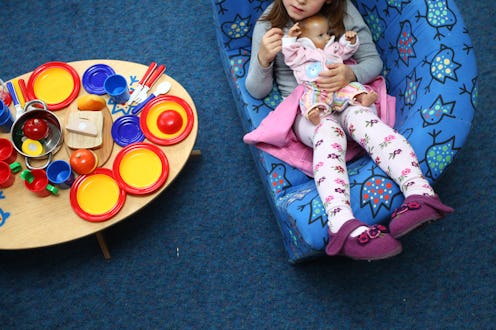Life
Kids Learn “Gendered” Colors At A SUPER Young Age — And The Consequences Are Lasting

From the time they are born, kids are bombarded with messages about what is appropriate for their gender. In fact, it even happens before they’re born; the whole premise of a gender reveal party is “blue is for boys, pink is for girls.” While colors in and of themselves may seem harmless, even inconsequential, a new study on kids’ perception of gender appropriate colors shows just how easily those perceptions are manipulated and how impactful they can be.
For their study, published in a new issue of the journal Sex Roles, researchers Sui Ping Yeung and Wang Ivy Wong studied a group of 129 kindergarteners in Hong Kong. First, Yeung and Wong gauged the five to seven year olds’ preconceived preferences for pink versus blue as well as green versus yellow. Then, they randomly divided the children into two groups: a label group (in which kids were told yellow is for girls and green is for boys) and a non-label group (in which kids were given no gender-specific reference for the colors).
A significant change in kids’ color preferences occurred when genders were assigned to yellow and green: both girls and boys in the label group expressed a greater liking of their gender-corresponding color than in the non-label group. In other words, simply telling a girl “yellow is for girls, green is for boys” make her more likely to prefer yellow over green.
These results show just how malleable kids’ perceptions on gender are and how that can affect their actions and preferences. “By applying gender labels, not only concrete materials such as toys could become gender-typed, but also abstract qualities such as colors,” the study states.
While the study focused specifically on color, its results present questions about how gendering “abstract qualities” might further impact kids’ perceptions. If being told a color is “for” a specific gender can cause a shift in mindset, imagine the effects of telling kids character traits, skills, and school subjects are “for” a specific gender. It’s not a far stretch to say that qualities like being caring and being strong are equally as gendered early on as, say, pink and blue.
As Science Daily points out, these results are in line with previous studies on gender schema which suggest “once children have learned a specific gender identity, their behavior will be guided by the standards set as being appropriate for their specific sex.” These gender associations guide preferences, and those preferences help people navigate the world.
It’s easy to track how these “gender-appropriate” rules can carry on throughout our entire lives: if girls are told to like pink and pink toys are primarily related to caregiving and fashion, who is being taught, early on, to value household chores and appearance?
Gender associations guide preferences, and those preferences help people navigate the world.
Researchers also measured performance in relation to gender labels, using yellow and green puzzles, in order to see whether the effects extended beyonce preference for a toy. While gender labels didn’t appear to have a negative effect on performance, researchers cautioned that as evidence for continuing to create color-divided products. Interestingly enough, the only demographic affected by these color labels in relation to puzzles was the boys: boys given a green puzzle, after being told “green is for boys,” performed better.
However, researchers hypothesized that this may speak more to preconceived notions about who is “good” at this type of problem solving. “Children may expect that boys are better at playing with a [puzzle],” researchers wrote. In turn, the gender cue may have “boosted their confidence,” leading them to perform better.
In recent years, many retailers and toy manufacturers have taken steps to eliminate gender specific toy aisles. In 2015, Target removed gender-based signs in kids’ sections. “We know that shopping preferences and needs change and, as guests have pointed out, in some departments like Toys, Home or Entertainment, suggesting products by gender is unnecessary,” a press release stated. “We heard you, and we agree.” Amazon is also among retailers who have removed boy and girl labels on their kids’ products.
While some may insist that girls just prefer dolls, there is little scientific evidence to back that up. As this new study suggests, social cues impact preference significantly. While the solution to sexism isn’t simply making everything gender neutral, being more conscious of color choices and the characteristics we associate is a necessary step toward equality in the toy aisle and beyond.